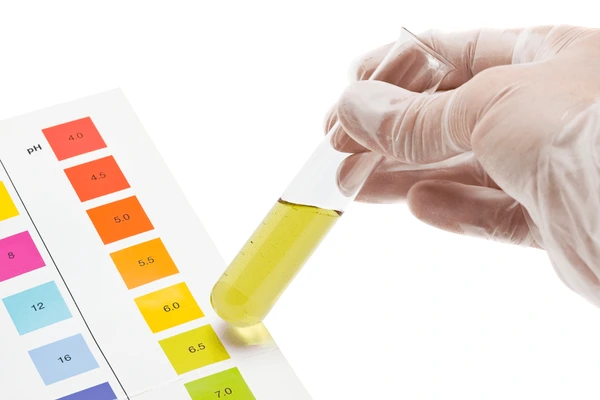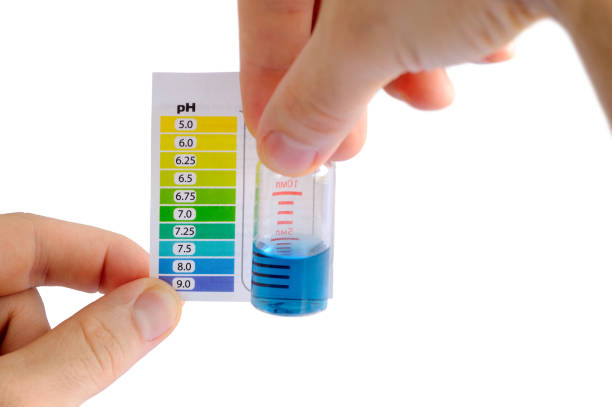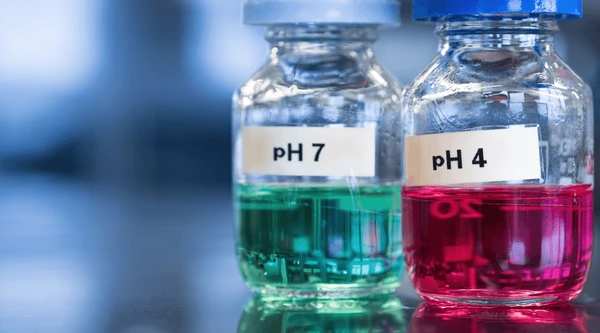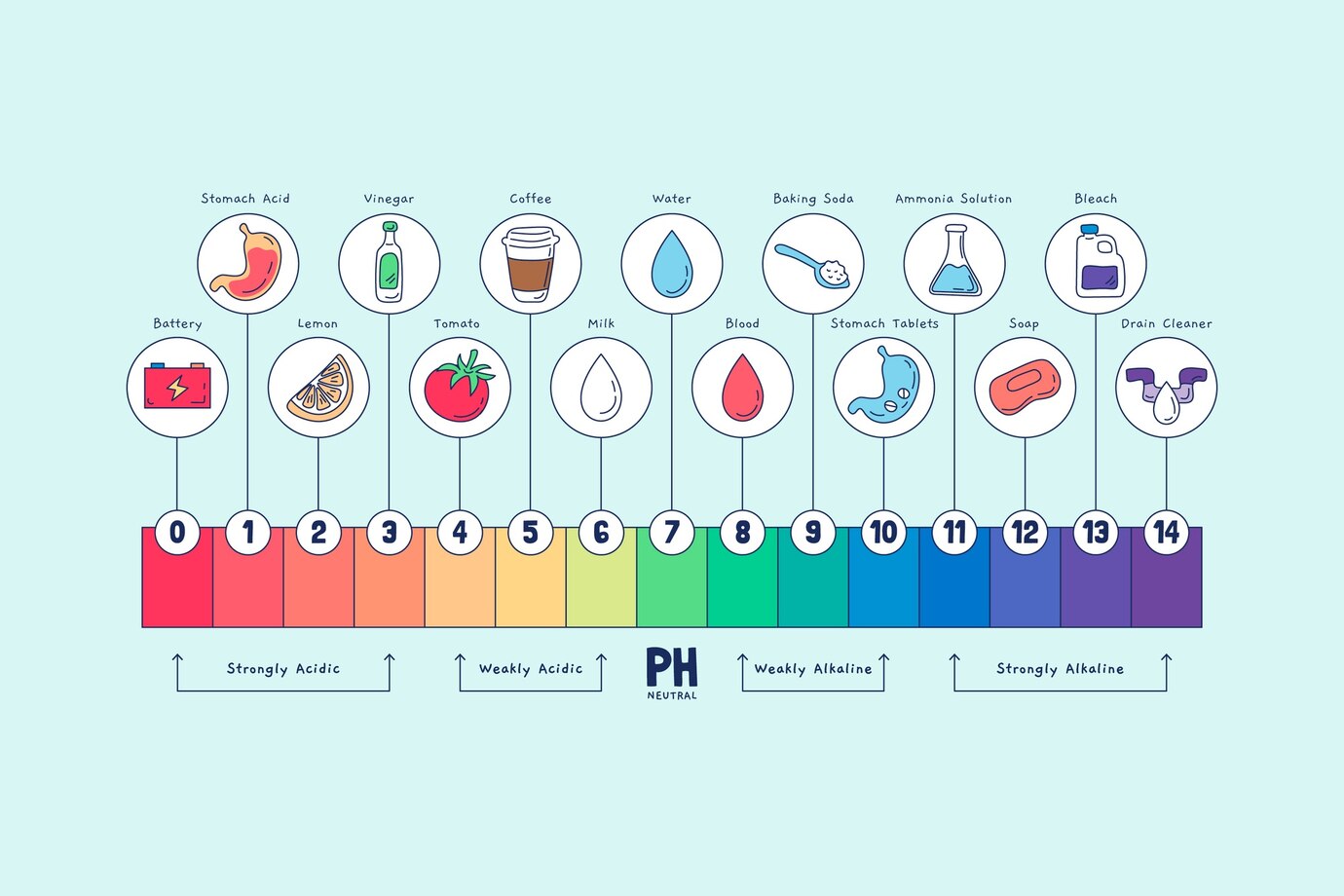The pH scale is a key concept in both chemistry and environmental science. It is used to measure how acidic or basic a substance is. It significantly affects biological systems, chemical processes, and industrial operations. A solid understanding of the pH scale is crucial for students, scientists, and professionals in a wide range of fields.
The pH scale is a logarithmic measurement ranging from 0 to 14 that indicates whether a solution is acidic or basic (alkaline). A pH of 7 is neutral, as seen in pure water. Values less than 7 signify acidity, while values greater than 7 indicate alkalinity.
- pH < 7: Acidic
- pH = 7: Neutral
- pH > 7: Alkaline (Basic)
Potential of hydrogen, or pH, describes the concentration of hydrogen ions (H⁺) within a solution.
History and Origin of the pH Scale
The pH scale was first introduced in 1909 by Danish chemist Søren P. L. Sørensen. Working at the Carlsberg Laboratory in Copenhagen, Sørensen devised the pH concept to help with his studies of protein analysis. Over time, scientists refined his idea, adding new ways to calculate and measure pH accurately.
The Science Behind the pH Scale

The pH value is determined by the following formula:
pH = -log[H⁺]
Where [H⁺] denotes the molar concentration of hydrogen ions within the solution. Since pH operates on a logarithmic scale, a change of one unit on the scale indicates a tenfold change in the hydrogen ion concentration.
For example:
- A solution with pH 3 has 10 times more H⁺ ions than a solution with pH 4.
- A solution with pH 3 has 100 times more H⁺ ions than a solution with pH 5.
Importance of the pH Scale in Everyday Life
Understanding the pH scale is crucial for various fields, from agriculture to medicine, water treatment, and cosmetics.
1. Human Body and Health
- The human body maintains a slightly alkaline blood pH of around 7.35-7.45.
- Abnormal pH levels can indicate conditions like acidosis (low pH) or alkalosis (high pH).
- The pH of stomach acid typically falls between 1.5 and 3.5, a range essential for both food digestion and bacterial elimination.
2. Agriculture and Soil Health
- Soil pH affects plant growth by influencing nutrient availability.
- The ideal pH range for most crops is between 6.0 and 7.5.
- Farmers test and adjust soil pH using lime (to raise pH) or sulfur (to lower pH).
3. Water Quality
- Drinking water should have a pH between 6.5 and 8.5.
- Acidic water can corrode pipes and leach toxic metals.
- Alkaline water may have an odd taste and reduce the effectiveness of disinfectants.
4. Industrial Applications
- pH control is essential in pharmaceuticals, food production, textile manufacturing, and chemical synthesis.
- Certain processes require strict pH ranges to ensure quality and safety.
Acids and Bases: Definitions and Examples
Acids
- A substance that donates hydrogen ions (H⁺) is called an acid.
- They have a sour taste, react with metals, and turn blue litmus paper red.
- Examples:
- Hydrochloric acid (HCl) – found in stomach acid
- Sulfuric acid (H₂SO₄) – used in car batteries
- Citric acid – found in citrus fruits
Bases
- Bases are defined by their ability to accept hydrogen ions or donate hydroxide ions (OH⁻).
- They feel slippery, taste bitter, and turn red litmus paper blue.
- Examples:
- Sodium hydroxide (NaOH) – used in soap making
- Ammonia (NH₃) – used in cleaning products
- Calcium hydroxide (Ca(OH)₂) – used in agriculture
Neutral Substances
- Neutral substances, like pure water, have an equal number of hydrogen and hydroxide ions, resulting in a pH of 7.
Strong vs. Weak Acids and Bases
The strength of an acid or base is a measure of its dissociation in water.
- Strong acids: Completely ionize in water (e.g., HCl, HNO₃).
- Weak acids: Partially ionize (e.g., acetic acid, citric acid).
- Strong bases: Fully dissociate into OH⁻ ions (e.g., NaOH, KOH).
- Weak bases: Partially dissociate (e.g., NH₃).
How to Measure pH

Several tools and methods are available to measure pH:
1. pH Paper or Litmus Paper
- Quick and easy, changes color based on pH.
- Gives approximate values, suitable for basic testing.
2. Universal Indicator
- A mixture of dyes that provides a full spectrum color change from red (acid) to violet (alkaline).
3. pH Meters
- Provide accurate and quantitative measurements.
- Common in laboratories and industries.
4. Digital Testers
- Portable devices are used for aquariums, soil, and water testing.
pH in Environmental Monitoring
Monitoring environmental pH is vital for ecological health:
- Acid rain has a pH below 5.6 and harms aquatic life, plants, and infrastructure.
- Ocean acidification, caused by CO₂ absorption, lowers the pH of seawater, affecting coral reefs and marine biodiversity.
- Wastewater treatment plants regulate pH to ensure effluent safety before releasing into water bodies.
Buffer Solutions and pH Stabilization

Buffers are solutions designed to minimize pH fluctuations when acids or bases are introduced. They are crucial in:
- Biological systems – maintaining stable internal conditions.
- Chemical manufacturing – preventing undesired reactions.
- Medical applications – in blood transfusions and IV fluids.
Common buffer systems include:
- Acetic acid/acetate
- Carbonic acid/bicarbonate in blood
The Role of pH in Skincare and Cosmetics
Skin’s natural pH is slightly acidic, around 5.5. Skincare products are formulated to match or support this balance to:
- Maintain a healthy skin barrier
- Prevent bacterial growth
- Reduce inflammation and dryness
Using products with inappropriate pH can lead to irritation or breakouts.
Role of pH in Cooking and Baking
- Lemon juice and vinegar make dishes tangy.
- Baking soda, a base, helps baked goods rise.
- Fermentation alters the pH, enhancing flavor and preservation.
Common Misconceptions about the pH Scale
- pH vs. Strength: A lower pH doesn’t always mean a stronger acid.
- Taste and pH: Not all acidic foods taste sour.
- Color and pH: A substance’s color doesn’t indicate its pH.
Case Studies Involving pH Levels
Flint Water Crisis
Improper pH levels corroded pipes, leading to lead contamination.
Coral Reef Bleaching
Changes in ocean pH disrupt marine ecosystems, harming coral reefs.
Future Research and Innovations
- Nano pH sensors for precision medicine
- Smart farming tools that monitor soil pH in real-time
- Advanced water purification systems using pH regulation
Conclusion: The Universal Importance of pH
The pH scale may seem like a small topic, but its impact is vast and significant. From keeping our bodies healthy to ensuring clean water and effective agriculture, pH plays a silent yet powerful role. Understanding how it works, where it’s used, and why it matters helps us make better decisions, scientifically and practically.
Accurate pH control is key whether you’re testing your garden soil, formulating a skincare product, or treating industrial effluent.
Why is the pH scale important?
How do I test the pH of water at home?
Can pH affect my health?
What is the difference between pH and acidity?
Is it possible to change the pH scale of a solution?
What is the pH scale?
The pH scale is a logarithmic measurement ranging from 0 to 14 that indicates whether a solution is acidic or basic (alkaline). A pH of 7 is neutral, as seen in pure water. Values less than 7 signify acidity, while values greater than 7 indicate alkalinity.
pH < 7: Acidic
pH = 7: Neutral
pH > 7: Alkaline (Basic)
Potential of hydrogen, or pH, describes the concentration of hydrogen ions (H⁺) within a solution.
History and Origin of the pH Scale
The pH scale was first introduced in 1909 by Danish chemist Søren P. L. Sørensen. Working at the Carlsberg Laboratory in Copenhagen, Sørensen devised the pH concept to help with his studies of protein analysis. Over time, scientists refined his idea, adding new ways to calculate and measure pH accurately.
The Science Behind the pH Scale
The pH value is determined by the following formula:
pH = -log[H⁺]
Where [H⁺] denotes the molar concentration of hydrogen ions within the solution. Since pH operates on a logarithmic scale, a change of one unit on the scale indicates a tenfold change in the hydrogen ion concentration.
For example: pH Scale
A solution with pH 3 has 10 times more H⁺ ions than a solution with pH 4.
A solution with pH 3 has 100 times more H⁺ ions than a solution with pH 5.
Importance of the pH Scale in Everyday Life
Understanding the pH scale is crucial for various fields, from agriculture to medicine, water treatment, and cosmetics.
1. Human Body and Health
The human body maintains a slightly alkaline blood pH of around 7.35-7.45.
Abnormal pH levels can indicate conditions like acidosis (low pH) or alkalosis (high pH).
The pH of stomach acid typically falls between 1.5 and 3.5, a range essential for both food digestion and bacterial elimination.
2. Agriculture and Soil Health
Soil pH affects plant growth by influencing nutrient availability.
The ideal pH range for most crops is between 6.0 and 7.5.
Farmers test and adjust soil pH using lime (to raise pH) or sulfur (to lower pH).
3. Water Quality
Drinking water should have a pH between 6.5 and 8.5.
Acidic water can corrode pipes and leach toxic metals.
Alkaline water may have an odd taste and reduce the effectiveness of disinfectants.
4. Industrial Applications
pH control is essential in pharmaceuticals, food production, textile manufacturing, and chemical synthesis.
Certain processes require strict pH ranges to ensure quality and safety.
Acids and Bases: Definitions and Examples
Acids
A substance that donates hydrogen ions (H⁺) is called an acid.
They have a sour taste, react with metals, and turn blue litmus paper red.
Examples: Hydrochloric acid (HCl) – found in stomach acid
Sulfuric acid (H₂SO₄) – used in car batteries
Citric acid – found in citrus fruits
Bases
Bases are defined by their ability to accept hydrogen ions or donate hydroxide ions (OH⁻).
They feel slippery, taste bitter, and turn red litmus paper blue.
Examples: Sodium hydroxide (NaOH) – used in soap making
Ammonia (NH₃) – used in cleaning products
Calcium hydroxide (Ca(OH)₂) – used in agriculture
Neutral Substances
Neutral substances, like pure water, have an equal number of hydrogen and hydroxide ions, resulting in a pH of 7.
Strong vs. Weak Acids and Bases
The strength of an acid or base is a measure of its dissociation in water.
Strong acids: Completely ionize in water (e.g., HCl, HNO₃).
Weak acids: Partially ionize (e.g., acetic acid, citric acid).
Strong bases: Fully dissociate into OH⁻ ions (e.g., NaOH, KOH).
Weak bases: Partially dissociate (e.g., NH₃).
How to Measure pH
Several tools and methods are available to measure pH:
1. pH Paper or Litmus Paper
Quick and easy, changes color based on pH.
Gives approximate values, suitable for basic testing.
2. Universal Indicator
A mixture of dyes that provides a full spectrum color change from red (acid) to violet (alkaline).
3. pH Meters
Provide accurate and quantitative measurements.
Common in laboratories and industries.
4. Digital Testers
Portable devices are used for aquariums, soil, and water testing.
pH in Environmental Monitoring
Monitoring environmental pH is vital for ecological health:
Acid rain has a pH below 5.6 and harms aquatic life, plants, and infrastructure.
Ocean acidification, caused by CO₂ absorption, lowers the pH of seawater, affecting coral reefs and marine biodiversity.
Wastewater treatment plants regulate pH to ensure effluent safety before releasing into water bodies.
Buffer Solutions and pH Stabilization
Buffers are solutions designed to minimize pH fluctuations when acids or bases are introduced. They are crucial in:
Biological systems – maintaining stable internal conditions.
Chemical manufacturing – preventing undesired reactions.
Medical applications – in blood transfusions and IV fluids.
Common buffer systems include:
Acetic acid/acetate
Carbonic acid/bicarbonate in blood
The Role of pH in Skincare and Cosmetics
Skin’s natural pH is slightly acidic, around 5.5. Skincare products are formulated to match or support this balance to:
Maintain a healthy skin barrier
Prevent bacterial growth
Reduce inflammation and dryness
Using products with inappropriate pH can lead to irritation or breakouts.
Role of pH in Cooking and Baking
Lemon juice and vinegar make dishes tangy.
Baking soda, a base, helps baked goods rise.
Fermentation alters the pH, enhancing flavor and preservation.
Common Misconceptions about the pH Scale
pH vs. Strength: A lower pH doesn’t always mean a stronger acid.
Taste and pH: Not all acidic foods taste sour.
Color and pH: A substance’s color doesn’t indicate its pH.
Case Studies Involving pH Levels
Flint Water Crisis
Improper pH levels corroded pipes, leading to lead contamination.
Coral Reef Bleaching
Changes in ocean pH disrupt marine ecosystems, harming coral reefs.
Future Research and Innovations
Nano pH sensors for precision medicine
Smart farming tools that monitor soil pH in real-time
Advanced water purification systems using pH regulation
Conclusion: The Universal Importance of pH
The pH scale may seem like a small topic, but its impact is vast and significant. From keeping our bodies healthy to ensuring clean water and effective agriculture, pH plays a silent yet powerful role. Understanding how it works, where it’s used, and why it matters helps us make better decisions, scientifically and practically.
pH Scale
What are buffer solutions?
Buffers are solutions designed to minimize pH fluctuations when acids or bases are introduced. They are crucial in:
Biological systems – maintaining stable internal conditions.
Chemical manufacturing – preventing undesired reactions.
Medical applications – in blood transfusions and IV fluids.
Common buffer systems include:
Acetic acid/acetate
Carbonic acid/bicarbonate in blood
pH Scale
What is the role of pH in Skincare and Cosmetics
Skin’s natural pH is slightly acidic, around 5.5. Skincare products are formulated to match or support this balance to:
Maintain a healthy skin barrier
Prevent bacterial growth
Reduce inflammation and dryness
Using products with inappropriate pH can lead to irritation or breakouts.
How to Measure the pH Scale?
1. pH Scale Paper or Litmus Paper
Quick and easy, changes color based on pH.
Gives approximate values, suitable for basic testing.
2. Universal Indicator
A mixture of dyes that provides a full spectrum color change from red (acid) to violet (alkaline).
3. pH Meters
Provide accurate and quantitative measurements.
Common in laboratories and industries.
4. Digital Testers
Portable devices are used for aquariums, soil, and water testing.
pH in Environmental Monitoring
Monitoring environmental pH is vital for ecological health:
Acid rain has a pH below 5.6 and harms aquatic life, plants, and infrastructure.
Ocean acidification, caused by CO₂ absorption, lowers the pH of seawater, affecting coral reefs and marine biodiversity.
Wastewater treatment plants regulate pH to ensure effluent safety before releasing into water bodies.
pH Scale
What are acids and bases?
Acids
A substance that donates hydrogen ions (H⁺) is called an acid.
They have a sour taste, react with metals, and turn blue litmus paper red.
Examples: Hydrochloric acid (HCl) – found in stomach acid
Sulfuric acid (H₂SO₄) – used in car batteries
Citric acid – found in citrus fruits
Bases
Bases are defined by their ability to accept hydrogen ions or donate hydroxide ions (OH⁻).
They feel slippery, taste bitter, and turn red litmus paper blue.
Examples: Sodium hydroxide (NaOH) – used in soap making
Ammonia (NH₃) – used in cleaning products
Calcium hydroxide (Ca(OH)₂) – used in agriculture
Neutral Substances
Neutral substances, like pure water, have an equal number of hydrogen and hydroxide ions, resulting in a pH of 7.
Strong vs. Weak Acids and Bases
The strength of an acid or base is a measure of its dissociation in water.
Strong acids: Completely ionize in water (e.g., HCl, HNO₃).
Weak acids: Partially ionize (e.g., acetic acid, citric acid).
Strong bases: Fully dissociate into OH⁻ ions (e.g., NaOH, KOH).
Weak bases: Partially dissociate (e.g., NH₃).
How to Measure pH
Several tools and methods are available to measure pH:
1. pH Paper or Litmus Paper
Quick and easy, changes color based on pH.
Gives approximate values, suitable for basic testing.
2. Universal Indicator
A mixture of dyes that provides a full spectrum color change from red (acid) to violet (alkaline).
3. pH Meters
Provide accurate and quantitative measurements.
Common in laboratories and industries.
4. Digital Testers
Portable devices are used for aquariums, soil, and water testing.
pH in Environmental Monitoring
Monitoring environmental pH is vital for ecological health:
Acid rain has a pH below 5.6 and harms aquatic life, plants, and infrastructure.
Ocean acidification, caused by CO₂ absorption, lowers the pH of seawater, affecting coral reefs and marine biodiversity.
Wastewater treatment plants regulate pH to ensure effluent safety before releasing into water bodies.
Buffer Solutions and pH Stabilization
Buffers are solutions designed to minimize pH fluctuations when acids or bases are introduced. They are crucial in:
Biological systems – maintaining stable internal conditions.
Chemical manufacturing – preventing undesired reactions.
Medical applications – in blood transfusions and IV fluids.
Common buffer systems include:
Acetic acid/acetate
Carbonic acid/bicarbonate in blood
The Role of pH in Skincare and Cosmetics
Skin’s natural pH is slightly acidic, around 5.5. Skincare products are formulated to match or support this balance to:
Maintain a healthy skin barrier
Prevent bacterial growth
Reduce inflammation and dryness
Using products with inappropriate pH can lead to irritation or breakouts.
Role of pH in Cooking and Baking
Lemon juice and vinegar make dishes tangy.
Baking soda, a base, helps baked goods rise.
Fermentation alters the pH, enhancing flavor and preservation.
Common Misconceptions about the pH Scale
pH vs. Strength: A lower pH doesn’t always mean a stronger acid.
Taste and pH: Not all acidic foods taste sour.
Color and pH: A substance’s color doesn’t indicate its pH.

8 thoughts on “pH Scale”